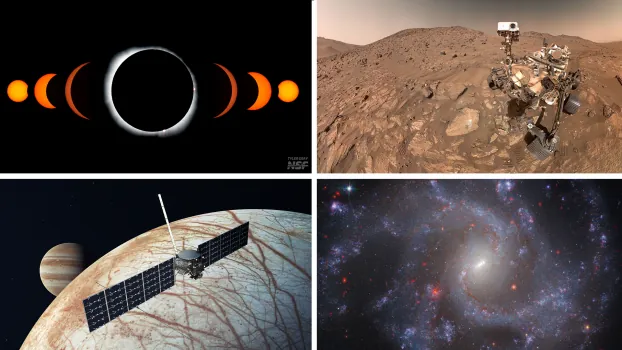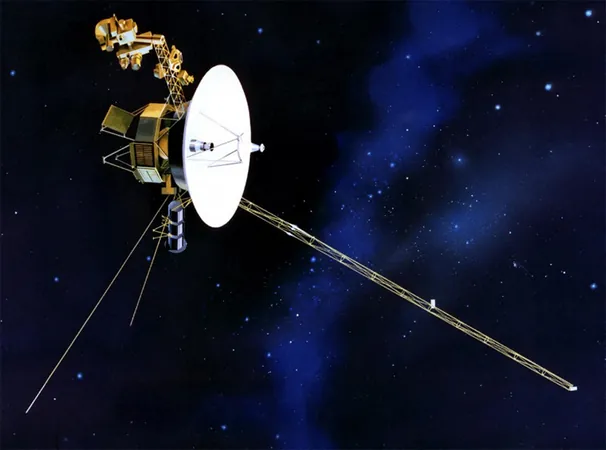
2024: A Landmark Year in Space Science with Moon Missions, Mars Exploration, and Groundbreaking Discoveries!
2024-12-31
Author: Ming
2024 proved to be a thrilling year for space science as a wave of new missions, significant milestones, and key discoveries unfolded across our solar system and beyond. This year witnessed three ambitious new lunar missions, amidst the backdrop of continuous exploration on Mars by NASA’s revolutionary Curiosity and Perseverance rovers.
Lunar Adventures: New Missions Launch and Failures
In January, Astrobotic’s Peregrine lunar lander, designed to deliver up to 100 kg of payload to the Moon, launched successfully aboard the United Launch Alliance’s Vulcan rocket. However, tragedy struck when it failed to achieve its objective and instead re-entered Earth's atmosphere due to a helium control valve failure. Although Peregrine didn’t land as planned, it provided critical data for future missions.
Counterbalancing this setback, Japan’s Smart Lander for Investigating Moon (SLIM) completed a successful landing, albeit in an unintended orientation. Nonetheless, SLIM's solar panels functioned effectively, allowing for valuable surface observations.
On February 22, Intuitive Machines made history with the Nova-C lander Odysseus, marking the first commercial lunar landing. Although it tipped over shortly after touchdown, it gathered scientific data for nearly a week.
In a significant achievement, China’s Chang’e 6 landed on June 1 in the Apollo Basin on the Moon's far side. The mission successfully retrieved lunar samples for the first time from this uncharted territory, providing invaluable insights into the Moon's history and geology.
Martian Discoveries: Rovers Push the Frontiers
Meanwhile, on Mars, the exploration continued at an unprecedented pace. The Perseverance rover celebrated over 1,000 sols (Martian days) of operation, during which it discovered organic compounds in a rock named "Cheyava Falls." This finding in the ancient riverbed hints at potential past life, showcasing the rover's role in revealing Mars's ancient environment.
Curiosity made groundbreaking discoveries as well, including the detection of pure sulfur rocks, previously unseen on Mars. These yellow sulfur crystals formed billions of years ago reveal a narrative of water's interactions with Martian geology.
Stellar Exploration: Missions to the Outer Solar System
Beyond the inner solar system, NASA's Europa Clipper mission took flight, setting its sights on Jupiter's enigmatic icy moon. Expected to arrive by 2030, this mission is pivotal in the quest to discover if extraterrestrial life exists beneath Europa's icy crust. The European Space Agency's Hera mission was also set in motion to investigate the aftermath of the DART mission's asteroid impact, demonstrating ever-developing planetary defense strategies.
Additionally, the Parker Solar Probe achieved a record-setting approach to our Sun, while the Voyager spacecraft continued their astounding journeys into interstellar space, providing invaluable data despite facing technical challenges.
X-ray Astronomy: A Year of Firsts
2024 marked a renaissance for X-ray astronomy with the launch of new telescopes, like Japan's XRISM, which unveiled its first stunning images early in the year. Despite budget challenges for the Chandra X-ray Observatory, the cutting-edge Hubble and James Webb Space Telescopes made groundbreaking observations, including insights into ancient galaxies formed within the universe's first billion years.
Celestial Events: Solar Eclipses and Solar Activity
This year also graced the Americas with two spectacular solar eclipses - a total eclipse in April and an annular eclipse in October, captivating millions. Unprecedented solar activity peaked in May, resulting in stunning auroras visible further south, as the sun reached its maximum phase in its 11-year solar cycle.
What Lies Ahead: Anticipations for 2025
Looking toward 2025, anticipation builds for more lunar landings, including missions from commercial partners like Firefly and Intuitive Machines. NASA's SPHEREx telescope is set to launch, promising to deepen our understanding of the cosmos.
With all that 2024 achieved, the journey to uncover the secrets of our universe is far from over. The next year promises even more exploration, discovery, and inspiration from beyond our planet.
(Lead image: Artistic depiction of Europa Clipper orbiting Jupiter and stunning captures from lunar missions.)

 Brasil (PT)
Brasil (PT)
 Canada (EN)
Canada (EN)
 Chile (ES)
Chile (ES)
 Česko (CS)
Česko (CS)
 대한민국 (KO)
대한민국 (KO)
 España (ES)
España (ES)
 France (FR)
France (FR)
 Hong Kong (EN)
Hong Kong (EN)
 Italia (IT)
Italia (IT)
 日本 (JA)
日本 (JA)
 Magyarország (HU)
Magyarország (HU)
 Norge (NO)
Norge (NO)
 Polska (PL)
Polska (PL)
 Schweiz (DE)
Schweiz (DE)
 Singapore (EN)
Singapore (EN)
 Sverige (SV)
Sverige (SV)
 Suomi (FI)
Suomi (FI)
 Türkiye (TR)
Türkiye (TR)
 الإمارات العربية المتحدة (AR)
الإمارات العربية المتحدة (AR)